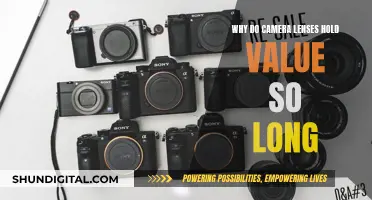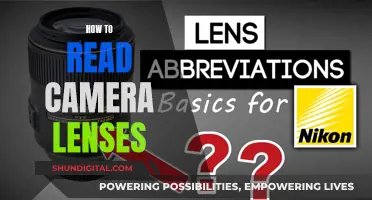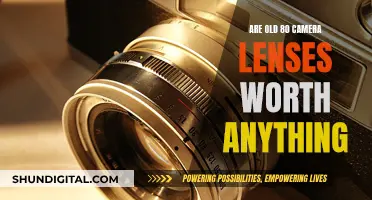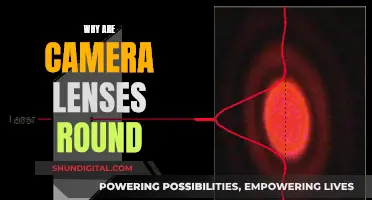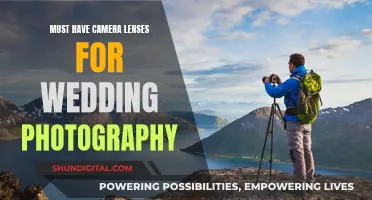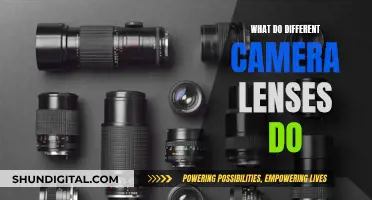
Choosing the right camera lens is crucial for achieving the perfect shot. There are two broad categories of lenses: prime and zoom. A prime lens has a fixed focal length, whereas a zoom lens has a variable focal length. The focal length of a lens determines the magnification of the image and the angle of view. Zoom lenses offer greater flexibility as you can change the composition by zooming in and out, but prime lenses generally produce sharper images.
There are also specialty lenses such as fisheye, wide-angle, macro, and telephoto lenses, each designed for specific situations. For example, wide-angle lenses are commonly used in landscape and architectural photography as they provide a wider field of view, while telephoto lenses are ideal for wildlife and sports photography as they allow you to get close-up shots from a distance.
| Characteristics | Values |
|---|---|
| Type | Prime, Zoom, Wide Angle, Telephoto, Super-Telephoto, Macro, Fisheye, Tilt-shift |
| Focal Length | 6mm-600mm+ |
| Aperture | Varies, e.g. F1.4, F2.8, F3.5-5.6 |
| Image Stabilisation | Optical Stabilisation, In-body Stabilisation |
| Format | Four Thirds, APS-C, Full-frame |
| Lens Mount | Micro Four Thirds, L-mount, Canon EF, Nikon F, Sony E |
What You'll Learn

Zoom lenses
When choosing a zoom lens, it's important to consider the trade-off between reach and speed. A standard zoom lens, such as the 24-105mm range, offers more reach, while a 24-70mm lens provides faster apertures, making it more suitable for low-light situations.
It's worth noting that while zoom lenses offer convenience and versatility, they may come with some compromises on image quality, weight, dimensions, aperture, autofocus performance, and cost. Additionally, the greater the range of focal length offered by a zoom lens, the more exaggerated these compromises may become.
Camera Lenses: Expensive, Fragile, and Worthy of Insurance Coverage
You may want to see also

Prime lenses
The main advantage of prime lenses is that they specialize in just one focal length, meaning they are finely tuned to deliver on one specific type of photography. For example, the 50mm prime lens, also known as the "Nifty Fifty", is considered standard because its focal length matches how we see the world with our human eyes. On the other hand, a 35mm prime lens is usually used by landscape photographers.
Bridge Cameras: Interchangeable Lenses and Their Limitations
You may want to see also

Wide-angle lenses
They are also useful in enclosed spaces, such as interiors of buildings, where the photographer cannot move far back from their subject.
However, wide-angle lenses are considered one of the most difficult types of lenses to learn how to use. They can distort the image, especially when it comes to photographing people, where features such as the nose or head can become disproportionately large if the photographer is too close to the subject.
When using a wide-angle lens, it is important to carefully organise the composition of the image, placing near and far objects in a way that achieves a clear image. It is also important to be aware of how edge and barrel distortion may impact the image.
Anti-Fog Wipes to Keep Camera Lenses Clear
You may want to see also

Telephoto lenses
A telephoto lens is a type of long-focus lens used in photography and cinematography. The physical length of the lens is shorter than the focal length. This is achieved by incorporating a special lens group, known as a telephoto group, which extends the light path to create a long-focus lens in a shorter overall design.
The telephoto group extends the light cone, making it appear as though the light has come from a lens with a much greater focal length. The simplest telephoto lens can be thought of as having two elements: one converging and one diverging. In practice, more than one element is used in each group to correct for aberrations. The combination of these two groups produces a lens that is physically shorter than a long-focus lens, but produces the same image size.
Renting Camera Lenses: Best Places to Get Them
You may want to see also

Macro lenses
Short macro lenses (35-60mm) are lightweight, easy to store and carry, and relatively inexpensive. However, they have a shorter working distance, which can be problematic when photographing insects, as they require a bit of distance. They also tend to produce less impressive bokeh.
Midrange macro lenses (80-105mm) offer a perfect working distance for flower photography, allowing photographers to capture abstract and impressionistic shots without getting too close or having other objects obstruct the view. These lenses are also relatively lightweight and can often be found at reasonable prices, especially from third-party manufacturers.
Long macro lenses (150-200mm) provide an excellent working distance, which is essential for insect photography. They deliver astonishingly good image quality, with sharp focus and pleasing bokeh. However, they tend to be heavy and expensive, making them a specialised tool for dedicated macro photographers.
When choosing a macro lens, it's important to consider factors such as physical requirements (size and portability), preferred subject matter, and style of photography. While there is no one-size-fits-all macro lens, selecting the ideal option based on these criteria will enhance your macro photography experience and help you capture the intricate details of the tiny worlds around us.
Cleaning Camera Lenses: Removing Rubber Residue
You may want to see also
Frequently asked questions
The two main types of camera lenses are prime and zoom. Prime lenses have a fixed focal length, while zoom lenses have a variable focal length.
A standard prime lens usually has a focal length of 50mm, which is considered "standard" because it matches how we see the world with our human eyes. Prime lenses are great for portrait, wedding, landscape, and streetscape photography, or any situation where the subject is mostly stationary.
A zoom lens offers a variable focal length, allowing you to zoom in and out on your subject. They are versatile and can be used for sports events, hiking, or any situation where you need to shoot both far away and up close.
Specialty lenses include fisheye, wide-angle, macro, and telephoto lenses. These lenses are used for more specific types of photography and offer unique features such as distorted images (fisheye), wider fields of view (wide-angle), extreme close-ups (macro), and super-close-up shots (telephoto).
Wide-angle lenses are commonly used in landscape and night photography as they provide a wider field of view, allowing you to capture more of the scene. They are also useful for real estate or architectural photography, as they can capture more of a confined interior space.


